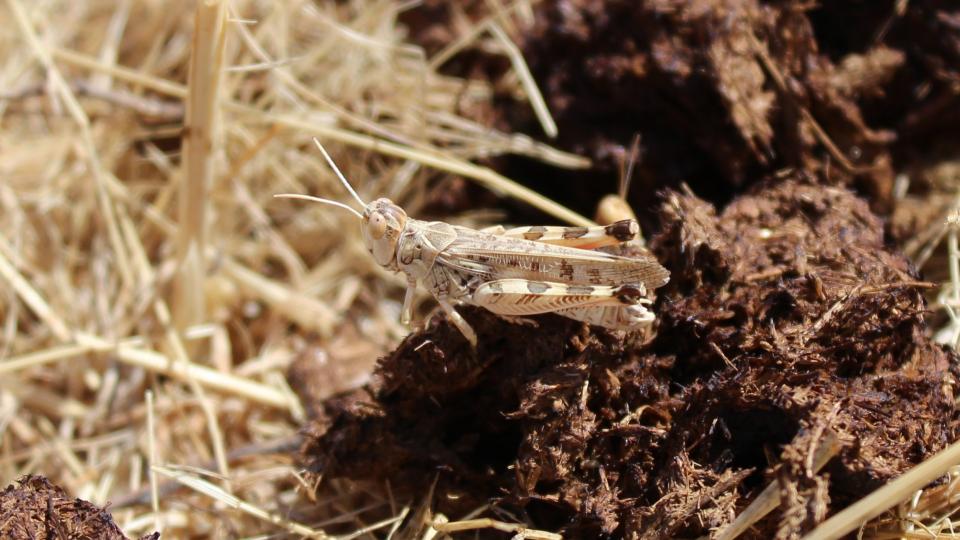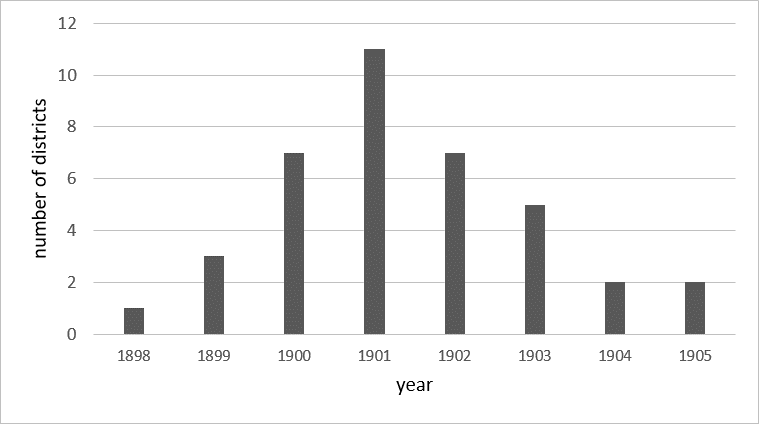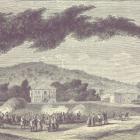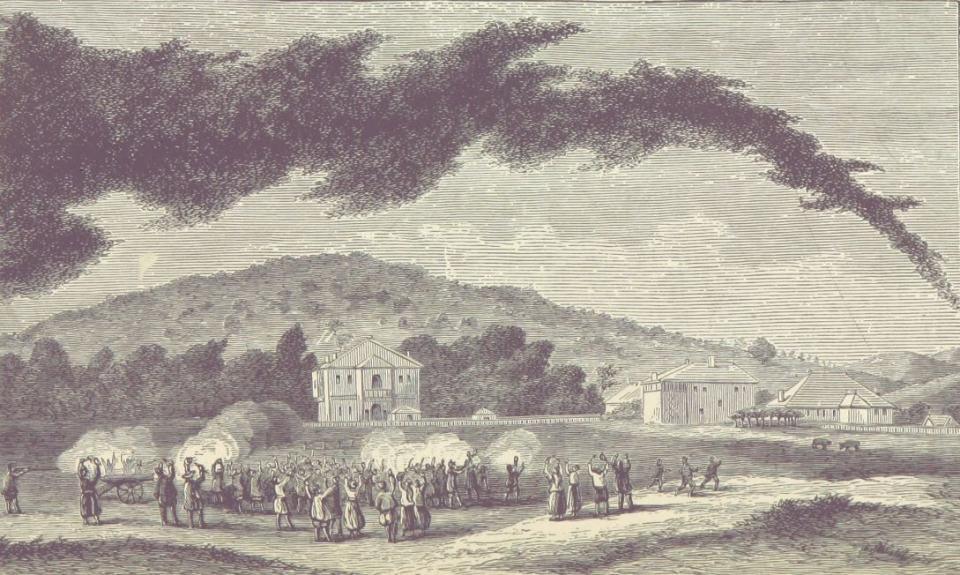
Drawing of a swarm of locusts, 1875.
Drawing of a swarm of locusts, 1875.
Courtesy of Europeana Collections.
Originally published in van Lennep, Henry J. Bible Lands: Their Modern Customs and Manners Illustrative of Scripture. New York: Harper & Brothers, 1875.
Click here to view source.
 This work is licensed under a Creative Commons Public Domain Mark 1.0 License.
This work is licensed under a Creative Commons Public Domain Mark 1.0 License.
Boundaries and borders have been widely debated by social, political, and behavioral scientists, as well as by geographers and biologists. These concepts concern much more than territorial lines and are constantly being reconfigured according to the continual interactions and intersections between various agents. In Jane Carruthers’s words, “the edge, whether cultural, political, ideological, geographical, or natural, is not a hard line but is permeable and, indeed, sometimes illusory.” This does not diminish the importance of borders, but it does make them a more complex object of study. Star and Griesemer coined the concept of “boundary objects,” a shared space that was useful in ensuring cooperation among agents who needed to break or overcome their own positions, perspectives, and intellectual boundaries to reach common grounds. Doré and Barbier applied this concept to locust outbreaks, defining “transitional boundary objects” in close relation to the locusts’ biological features. As revealed by Uvarov, locusts have two density-dependent phases, mediated by a transitional period. In the solitary phase, locusts are innocuous to field crops and, thus, are tolerated in the daily lives of rural societies. In turn, after the transition to the gregarious phase, they form migrant swarms, causing agricultural damage, being perceived as outsiders and harmful invaders. In English, a semantic boundary reflects this change: individuals in the solitary phase are called “grasshoppers” and those in the gregarious phase are called “locusts.” Surveillance systems to control outbreaks are based on the identification of the border zone between these two phases, i.e., on the identification of the transitional phases, essential to the successful implementation of control measures in case of a sudden increase in the density of populations. One of the major surges of the Moroccan locust (Dociostaurus maroccanus) in the Iberian Peninsula (1898–1905), which we studied, exposes some of the manifold borders entangled with locust outbreaks, their recognition and control, and how those borders often reflect local and nonexpert perspectives.
In 1898, a huge swarm crossed the southwestern Spanish border, entering the Algarve (Portugal). The locusts were not promptly identified as the Moroccan locust, a common species in Portugal, but were misidentified as the desert locust (Schistocerca gregaria) which, occasionally, invaded the south of Portugal, causing little damage. They were, thus, mostly ignored. However, the following spring, the eggs which had been laid in the ground started to hatch, and the locusts started feeding on crops and flying to distant places. People realized that the Moroccan locust was the species responsible for the previous year’s invasion, but it was too late to avoid the extended invasion that would last until 1905. How could locals not have recognized the familiar insect, which naturally inhabits Iberian landscapes? The identification of an individual is not an unambiguous process, as it is generally understood, but one full of borders, often difficult to distinguish. In this case, a biological border not only defined two species but also established two different forms within each species. Although the Moroccan and the desert locusts have different morphological traits, for nonexperts, the major observable difference is behavioral. The Moroccan locust is usually seen in Portugal in the solitary phase; the desert locust is only present in the gregarious phase. Thus, in 1898, locusts in different phases were considered different species. A cultural border based on behavioral traits defined the two apparently different species. People did not know that there was a transitional border zone which connected two individual types from one species, leading, hence, to a delay in the application of control measures.
Locusts fly beyond countries’ borders. The fight against the insects should, thus, have been a transnational task in the Iberian Peninsula. If Iberians wanted to avoid upsurges, the anti-locust measures should have taken the form of a joint, coherent, and coordinated action between Spain and Portugal. Regulations to control locust outbreaks reveal that a similar “modus operandi” was employed to fight the insects in Portugal and Spain. Both countries destroyed locust eggs by plowing or harrowing lands where they had been laid and by catching insects by hand or using nets or traps, destroying them afterwards—by burying, burning, or killing them with chemicals. However, reports from Portuguese authorities responsible for killing the locusts, as well as descriptions in newspapers, did not recognize those similarities, demanding articulation, collaboration, or transnational cooperation between the governments to set a common anti-locust program in motion. In fact, the pattern of locusts’ incidence between 1898 and 1905 suggests a self-regulating process linked with a natural fluctuation in relative abundance. Control measures were purely palliative. Ineffective anti-locust campaigns in Portugal were not related to unsuccessful Spanish campaigns. Neighboring populations erroneously perceived an undesirable border, which divided the territory, preventing the success of Portuguese campaigns against locusts.
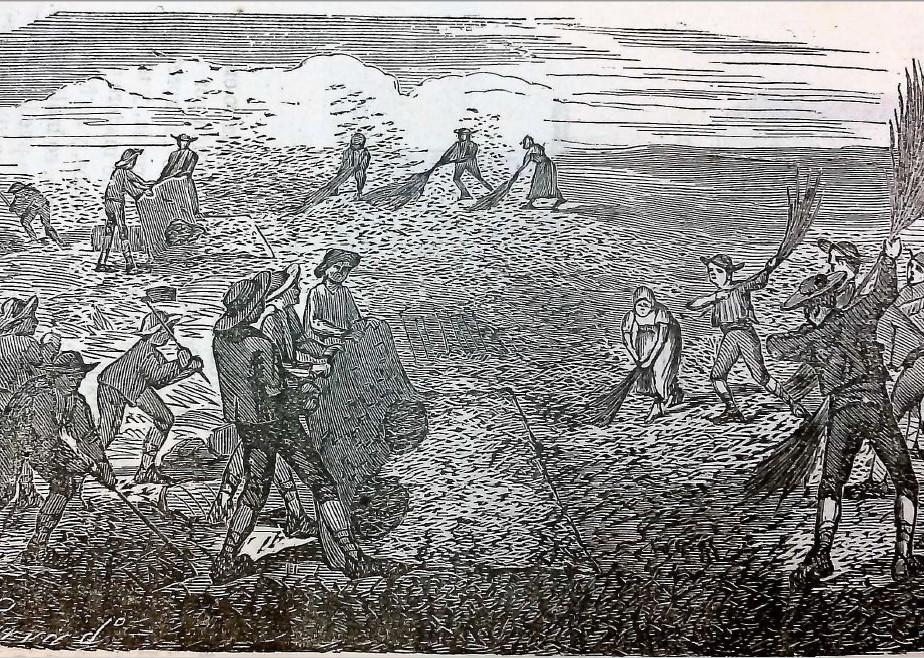
Nineteenth-century depiction of mechanical methods for locust control.
Nineteenth-century depiction of mechanical methods for locust control.
Originally published in Salido y Estrada, Agustin. La Langosta. Madrid: Impr., Fundicion y Estereotipia de J. Aguado, 1874: 392.
Click here to view HathiTrust source.
 This work is licensed under a Creative Commons Public Domain Mark 1.0 License.
This work is licensed under a Creative Commons Public Domain Mark 1.0 License.
Bio-invasions in general, and locust invasions in particular, have been studied from an ecological perspective. Environmental humanities provoke us to rethink disciplinary boundaries, as suggested by Bergthaller et al. In this context, the fluidity of concepts and perceptions regarding locust invasions, in contrast with the claim of broad consensus around scientific knowledge, makes boundaries and “boundary objects” interesting conceptual tools with which to discuss the relevance of considering people’s perceptions of the outbreaks. This is crucial if we are to better understand this past struggle against locusts, in its successes and failures. To address the dynamics of nature—and locust outbreaks, in particular—one must grapple with diverse borders: among various social groups and different intervenient actors, and among various nations, as well as in the interstices of diverse disciplines.
How to cite
Gomes, Inês, and Ana Isabel Queiroz. “The Manifold Borders of a Locust Outbreak.” Environment & Society Portal, Arcadia (Spring 2019), no. 15. Rachel Carson Center for Environment and Society. doi.org/10.5282/rcc/8636.
ISSN 2199-3408
Environment & Society Portal, Arcadia
 This work is licensed under a Creative Commons Attribution 4.0 International License.
This work is licensed under a Creative Commons Attribution 4.0 International License.
2019 Inês Gomes and Ana Isabel Queiroz
This refers only to the text and does not include any image rights.
Please click on an image to view its individual rights status.
- Carruthers, Jane. “Environmental History with an African Edge.” In “The Edges of Environmental History: Honouring Jane Carruthers,” edited by Christof Mauch and Libby Robin, RCC Perspectives, no. 1 (2014): 9–16.
- Star, Susan Leigh, and James R. Griesemer. “Institutional Ecology, ‘Translations’ and Boundary Objects: Amateurs and Professionals in Berkeley’s Museum of Vertebrate Zoology, 1907–39.” Social Studies of Science 19, no. 3 (1989): 387–420.
- Doré, Antoine, and Marc Barbier. “Maintenir la vigilance. Les objets-frontières-transationnels dans la pérennisation des dispositifs de surveillance des ‘soldats de Dieu.’” Revue d’anthropologie des connnaissances 9, no. 2 (2015): 189–212.
- Uvarov, Boris P. Locusts and Grasshoppers. London: Imperial Bureau of Entomology, 1928.
- Gomes, Inês, Ana Isabel Queiroz, and Daniel Alves. “Iberians Against Locusts: Fighting Cross-Border Bio-Invaders (1898–1947).” Historia Agraria 78 (August 2019): 127–159.
- Humair, Franziska, Peter J. Edwards, Michael Siegrist, and Christoph Kueffer. “Understanging Misunderstandings in Invasion Science: Why Experts Don’t Agree on Common Concepts and Risk Assessments.” Neobiota 20 (2014): 1–30.
- Bergthaller, Hannes, et al. ”Mapping Common Ground: Ecocriticism, Environmental History, and the Environmental Humanities.” Environmental Humanities 5 (2014): 261–276


